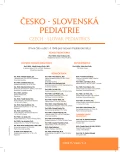How to assess high-sensitive troponin T in newborns?
Authors:
P. Jehlička 1; M. Matas 2; D. Rajdl 3; M. Huml 1; A. Mocková 2; J. Dort 2; P. Brož 3; J. Sýkora 1
Authors‘ workplace:
Dětská klinika, Fakultní nemocnice v Plzni, Univerzita Karlova v Praze, Lékařská fakulta v Plzni
přednosta prof. MUDr. J. Sýkora, Ph. D.
1; Neonatologické oddělení, Fakultní nemocnice v Plzni, Univerzita Karlova v Praze, Lékařská fakulta v Plzni
primář doc. MUDr. J. Dort, Ph. D.
2; Ústav klinické hematologie a biochemie, Fakultní nemocnice v Plzni, Univerzita Karlova v Praze, Lékařská fakulta v Plzni
přednosta prof. MUDr. J. Racek, DrSc.
3
Published in:
Čes-slov Pediat 2016; 71 (4): 212-215.
Category:
Original Papers
Overview
In the prospective study cord blood samples were tested for high-sensitivity troponin T reference concentration in 454 healthy full termed newborns. The hscTnT levels in healthy newborns were significantly higher than levels in adult population (median [IQR] 38.2 [31.3–48.0] ng/l, reference interval: 20.1–83.0 ng/l). We found statistically higher hscTnT in boys when compared to girls (p=0.05). Concentrations of hscTnT were lower in newborns who underwent cesarean section than delivered vaginally (p=0.008). Furthermore, hscTnT was statistically significantly decreased in hemolytic blood samples (hemolysis level >2 g/l, p<0.05). Identified reference values of hscTnT based on this study may contribute to more precise assessment of newborns with suspicion of a myocardial disorder.
Key words:
high-sensitivity troponin T, newborns, myocardial disorder, hemolysis
Sources
1. Baum H, Hinze A, Bartels P, et al. Reference values for cardiac troponins T and I in healthy neonates. Clin Biochem 2004; 37 (12): 1079–1082.
2. Clark SJ, Newland P, Yoxall CW, et al. Cardiac troponin T in cord blood. Arch Dis Child Fetal Neonatal Ed 2001; 84 (1): 34–37.
3. Zou Han-Liang. Determination and analysis of high-sensitivity cardiac troponin-T in neonates with pathological jaundice. Laboratory Medicine 2013; 28 (4): 267–270.
4. Cruz MA, Bremmer YA, Porter BO, et al. Troponin T and cardiac dysfunction in extremely low-birth-weight infants. Pediatr Cardiol 2006; 27 (4): 396–401.
5. Mingels AM, Jacobs LH, Kleijnen VW, et al. Cardiac troponin T elevations, using highly sensitive assay, in recreational running depend on running distance. Clin Res Cardiol 2010; 99 (6): 385–391.
6. Apple FS. A new season for cardiac troponin assays: it‘s time to keep a scorecard. Clin Chem 2009; 55 (7): 1303–1306.
7. Mahajan VS, Jarolim P. How to interpret elevated cardiac troponin levels. Circulation 2011; 124 (21): 2350–2354.
8. Stein GY, Alon D, Korenfeld R, et al. Clinical implications of high-sensitivity cardiac troponin measurements in hospitalized medical patients. PLoS One 2015; 10 (1): 0117162.
9. Trevisanuto D1, Zaninotto M, Altinier S, et al. High serum cardiac troponin T concentrations in preterm infants with respiratory distress syndrome. Acta Paediatr 2000 Sep; 89 (9): 1134–1136.
10. Costa S1, Zecca E, De Rosa G, et al. Is serum troponin T a useful marker of myocardial damage in newborn infants with perinatal asphyxia? Acta Paediatr 2007 Feb; 96 (2): 181–184.
11. Soongswang J, Durongpisitkul K, Nana A, et al. Cardiac troponin T: a marker in the diagnosis of acute myocarditis in children. Pediatr Cardiol 2005; 26 (1): 45–49.
12. Giacchi V, Mattia C, Betta P, et al. Should we consider bilirubin when dosing troponin in newborns? Int J Clin Case Stud 2014; 1 : 101.
13. Bais R. The effect of sample hemolysis on cardiac troponin I and T assays. Clin Chem 2010; 56 : 1357–1359.
14. Li A, Brattsand G. Stability of serum samples and hemolysis interference on the high sensitivity troponin T assay. Clinical Chemistry & Laboratory Medicine 2011; 49 : 335–336.
Labels
Neonatology Paediatrics General practitioner for children and adolescentsArticle was published in
Czech-Slovak Pediatrics

2016 Issue 4
Most read in this issue
- How to assess high-sensitive troponin T in newborns?
- Current perspectives on inherited bone marrow syndromes
- Rectal suction biopsy in clinical practice
- Bonding support after child birth
